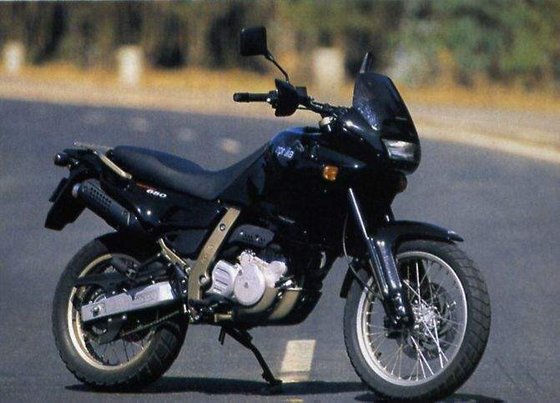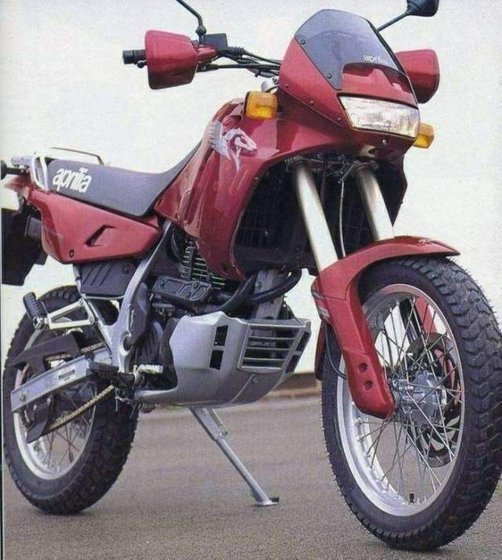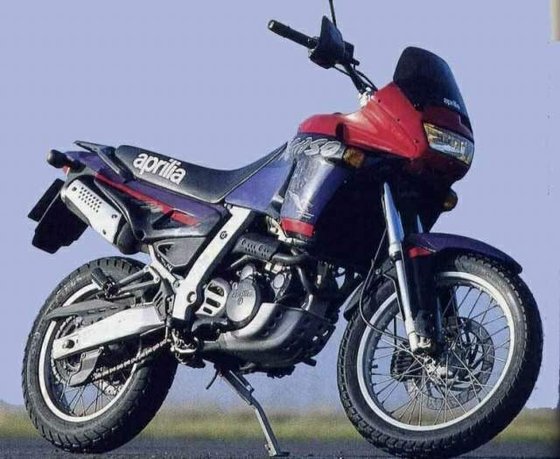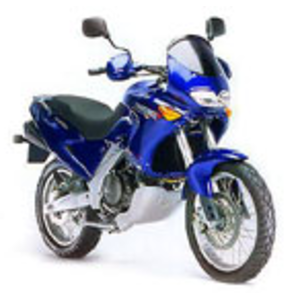Aprilia Pegaso 650 [1992–1996]: A Versatile Single-Cylinder Contender Revisited

Introduction
The Aprilia Pegaso 650, produced between 1992 and 1996, stands as a testament to Italian engineering’s ability to blend rugged off-road capability with street-friendly agility. Built around Rotax’s robust single-cylinder engine and wrapped in a futuristic design, the Pegaso carved a niche in the dual-sport segment during its era. This review dives into what made this bike a standout—and where it left riders wanting more—all from the perspective of a modern-day test ride. Whether you’re a current owner or a vintage enthusiast, understanding the Pegaso’s quirks and strengths might just inspire your next garage project—or a parts upgrade from MOTOPARTS.store.
Design & Styling: Form Meets Functionality

The Pegaso 650’s design is a masterclass in 90s Italian flair. Its angular bodywork, sharp lines, and compact proportions give it a “futuristic trailbike” aesthetic that still turns heads today. The composite steel-and-alloy frame isn’t just eye candy; it’s remarkably light, contributing to a dry weight of 157–160 kg (346–353 lbs). For a 650cc machine, that’s featherweight by modern standards.
The seat height ranges from 846–860 mm (33.1–33.9 inches), which is manageable for average riders, though shorter legs might tip-toe at stops. The cockpit feels purposeful, with a narrow profile that aids maneuverability. Practical touches include a sturdy rear rack (sans plastic coating—a rare oversight) and grippy footpegs. The liquid-cooled engine is tightly packaged, almost resembling a “juice carton squashed by a bear,” as one journalist poetically noted. Chrome-finished fork sliders and a sculpted tail section add premium touches uncommon in its class.
Engine & Performance: Torque Over Top-End

At the heart of the Pegaso lies Rotax’s 652cc single-cylinder engine, a DOHC powerhouse with five valves—a rarity that boosts high-RPM breathing. Yet, it’s the midrange where this mill shines. With 48–50 HP (35–36.5 kW) peaking at 6,250–7,000 RPM and a hearty 59 Nm (43.5 lb-ft) of torque arriving early at 6,500 RPM, the Pegaso pulls strongly from 1,500 RPM onward.
On the Road:
- Low-End Grunt: The engine’s tractor-like torque makes stoplight launches and uphill climbs effortless. Vibrations are noticeable above 5,000 RPM, but below that, it’s surprisingly smooth for a big single.
- Gearing: The 5-speed transmission is crisp, though a sixth gear would’ve eased highway cruising. Top speed hovers around 160–172 km/h (99–107 mph), depending on gearing and rider weight.
- Fuel Efficiency: Averaging 5.2–5.6 L/100 km (45–41 MPG), the Pegaso sips fuel—a boon for adventure touring.
Carburetion Quirks:
Dual Mikuni BST33 carburetors deliver steady throttle response, though cold starts occasionally require patience. Upgrading to modern jets or a fuel injection kit (available at MOTOPARTS.store) could refine this further.
Handling & Ride Experience: A Street-Biased Trailblazer
The Pegaso’s chassis is its crowning achievement. The upside-down 41mm forks and monoshock (both preload-adjustable) offer 210 mm (8.3 inches) of travel—plush enough for gravel roads but tuned for pavement precision.
On-Road Manners:
- Flickable Geometry: With a 1,480 mm (58.3-inch) wheelbase and 19-inch front wheel, the Pegaso dives into corners eagerly. The stock Pirelli MT60 tires, however, are a letdown. As noted in period reviews, they’re “fit only for setting on fire.” Swapping to modern dual-sport rubber (like Michelin Anakee or Metzeler Tourance) transforms grip.
- Braking: The single 300mm front disc with a twin-piston caliper delivers adequate stopping power, but the spongy feel from the long brake lines (a carryover from the 600cc model) demands stainless-steel hoses for sharper feedback.
Off-Road Limits:
While the Pegaso’s 200 mm (7.9-inch) ground clearance and suspension travel suggest trail prowess, its street-biased weight distribution and bodywork make serious off-roading a challenge. It’s more “adventure-light” than hardcore enduro.
Competition: How Does the Pegaso Stack Up?
The Pegaso 650 faced stiff rivals in the 90s dual-sport arena:
- BMW F650 Funduro:
- Similar Rotax engine but detuned to 48 HP.
- Heavier at 183 kg (403 lbs) yet more off-road capable.
-
Pegaso counters with sharper handling and lower maintenance costs.
-
Yamaha XTZ660 Super Ténéré:
- 5-valve engine with 50 HP but weighs 187 kg (412 lbs).
-
Superior long-distance comfort but less agile.
-
Honda NX650 Dominator:
- Air-cooled simplicity with 43 HP.
- Lacks the Pegaso’s refinement but wins in reliability.
Verdict: The Pegaso strikes a middle ground—lighter than the BMW, nimbler than the Yamaha, and more sophisticated than the Honda. Its Achilles’ heel? Limited dealer support compared to Japanese rivals, making aftermarket parts crucial for longevity.
Maintenance: Keeping the Pegaso Thriving
Owners praise the Pegaso’s mechanical simplicity, but neglect can lead to headaches. Here’s a proactive maintenance checklist:
Key Service Intervals:
- Oil Changes: Every 5,000 km (3,100 miles) with SAE 10W-50 (1.7L capacity). Use a quality filter—MOTOPARTS.store stocks OEM-spec replacements.
- Valve Adjustments: Every 10,000 km (6,200 miles). Cold clearance: 0.15–0.25 mm for both intake and exhaust.
- Coolant: Replace every 2 years. Capacity: 1.8L.
- Chain & Sprockets: The 16/47 sprocket combo wears quickly if neglected. Upgrade to DID X-ring chains for durability.
Common Upgrades:
- Brakes: Swap to sintered pads and steel-braided lines for sharper response.
- Suspension: Progressive springs and fresh fork oil rejuvenate the aging setup.
- Electrics: The CDI ignition is reliable, but keep spare NGK D8EA/DR8EIX plugs on hand.
Tire Recommendations:
- Road Focus: Bridgestone Battlax Adventure A41
- Mixed Terrain: Pirelli Scorpion Rally STR
- Off-Road: Mitas E-07
Final Thoughts: A Forgotten Gem Worth Reviving
The Aprilia Pegaso 650 isn’t perfect—its tires and brakes show their age, and vibes at highway speeds remind you it’s a single. Yet, few bikes from the 90s balance urban agility and backroad fun so effectively. With thoughtful upgrades (readily available through MOTOPARTS.store), the Pegaso transforms into a capable modern classic. Whether you’re chasing vintage rallies or weekend café rides, this Italian underdog deserves a second look—and a spot in your garage.
Ready to revitalize your Pegaso? Explore our curated selection of parts and accessories tailored for 90s classics at MOTOPARTS.store.
Specifications sheet
| Engine | |
|---|---|
| Stroke: | Four-stroke |
| Max power: | 50 kW | 67.0 hp |
| Max torque: | 59 Nm |
| Fuel system: | 2 x Mikuni BST33 carburetors |
| Max power @: | 7000 rpm |
| Displacement: | 652 ccm |
| Fuel control: | Double Overhead Cams (DOHC) |
| Max torque @: | 6500 rpm |
| Bore x stroke: | 100.0 x 83.0 mm (3.9 x 3.3 in) |
| Configuration: | Single |
| Cooling system: | Liquid |
| Compression ratio: | 9.0:1 |
| Number of cylinders: | 1 |
| Valves per cylinder: | 5 |
| Dimensions | |
|---|---|
| Wheelbase: | 1480 mm (58.3 in) |
| Dry weight: | 157 |
| Wet weight: | 200 |
| Seat height: | 846 mm (33.3 in) (adjustable) |
| Overall width: | 880 mm (34.6 in) |
| Overall height: | 840 mm (33.1 in) |
| Overall length: | 2180 mm (85.8 in) |
| Ground clearance: | 200 mm (7.9 in) |
| Fuel tank capacity: | 14.0 L (3.7 US gal) |
| Drivetrain | |
|---|---|
| Final drive: | chain |
| Transmission: | 5-speed |
| Rear sprocket: | 47 |
| Front sprocket: | 16 |
| Maintenance | |
|---|---|
| Rear tire: | 140/70-17 |
| Engine oil: | 10W50 |
| Front tire: | 100/90-19 |
| Idle speed: | 1400 RPM |
| Brake fluid: | DOT 4 |
| Spark plugs: | NGK D8EA, NGK DR8EIX |
| Spark plug gap: | 0.7 |
| Coolant capacity: | 2.0 |
| Forks oil capacity: | 1.1 |
| Engine oil capacity: | 2.0 |
| Engine oil change interval: | Every 5000 km or 2 years |
| Valve clearance (intake, cold): | 0.15–0.25 mm |
| Valve clearance (exhaust, cold): | 0.15–0.25 mm |
| Recommended tire pressure (rear): | 1.9 bar (28 psi) solo, 2.3 bar (33 psi) with passenger |
| Recommended tire pressure (front): | 1.7 bar (25 psi) |
| Chassis and Suspension | |
|---|---|
| Frame: | Composite steel and alloy |
| Rear brakes: | Single 220 mm disc, 1-piston caliper |
| Front brakes: | Single 300 mm disc, 2-piston caliper |
| Rear suspension: | Monoshock, preload and rebound adjustable |
| Front suspension: | 41 mm upside-down forks, preload adjustable |
| Rear wheel travel: | 210 mm (8.3 in) |
| Front wheel travel: | 210 mm (8.3 in) |



















